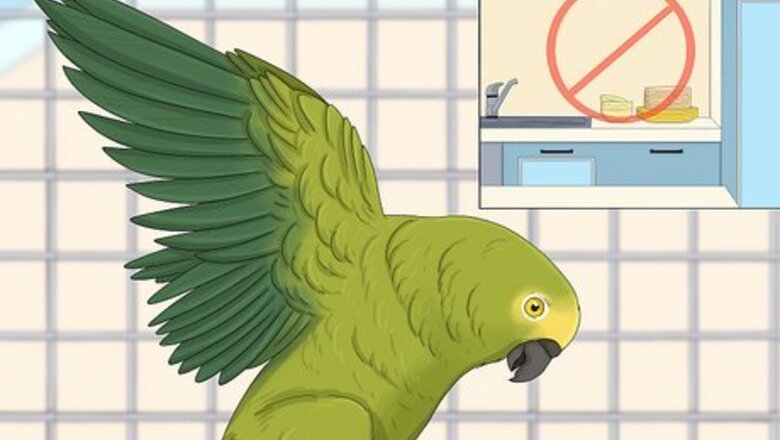
views
Eliminating the Bird's Sources of Stress
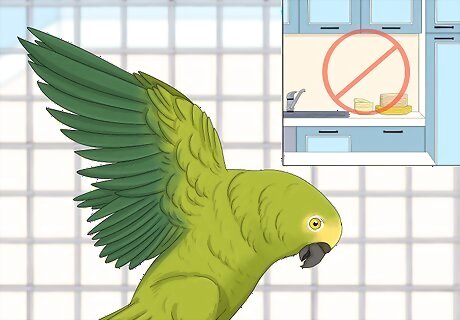
Check your bird's environment and diet to make sure they're correct. Amazon parrots need enough space to move around comfortably. They are also a smart animal that needs stimulation and usually enjoy being near the family. However, your bird should also feel safe, so place the cage with one side against a wall. Your parrot will need a varied diet consisting of seeds or specially-formulated pellets, along with fruits and vegetables. You can also feed them nuts as a treat. Make sure that there are no loud noises near your parrot's cage, like a TV or radio. Don't place your parrot in the kitchen because fumes from Teflon coated pots or pans can harm or kill your bird.
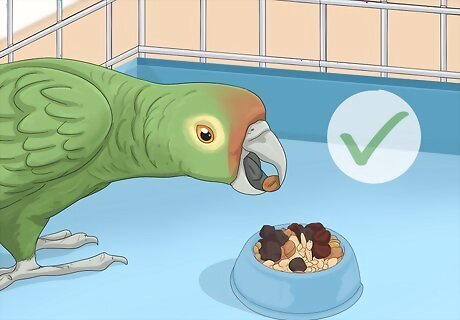
Feed your Amazon parrot enough. Your parrot should eat enough to maintain a relatively constant weight. If your aggressive Amazon often empties its food and water bowls completely, try giving it a bit more food and water next time you feed it. The amount of food a parrot needs may vary with the season. Since Amazon parrots include dozens of species, each of which has a different average mass, it is impossible to generalize about how much your pet should weigh. To determine your bird’s healthy weight, consult its most recent veterinary records. If you don’t have the records on hand, contact your vet and ask for the information. Since there’s no way to know exactly how much food your aggressive parrot will want at a given time, provide it with food at all times.
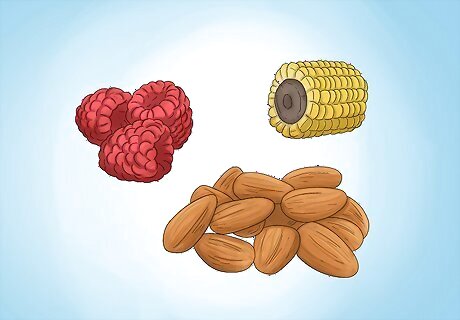
Feed your Amazon parrot a variety of foods. It’s not enough to merely give your pet bird enough food. It must also get food that is varied and stimulates its appetite. Give your Amazon parrot a variety of foods each day. For instance, you might give your Amazon parrot: Fruits (plums, kiwis, raspberries, blueberries, cantaloupe slices) Vegetables (corn, bok choy, lentils, baked sweet potato, zucchini) Nuts and seeds (almonds, walnuts, sprouted sunflower seeds)
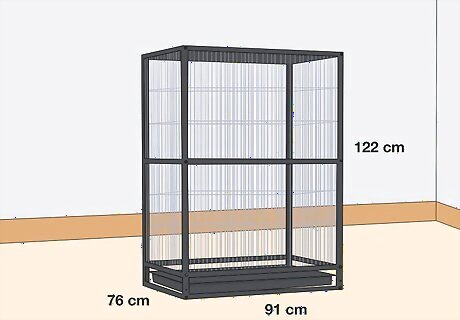
Change your parrot’s cage if it's too small. An Amazon requires a cage of at least 30” x 36” x 48” (76 x 91 x 122 cm ) with space of 3/4” to 1” (2 to 2.5 cm) between the bars. Cages that are too small could cause your Amazon to lash out due to feeling trapped.

Provide adequate lighting. If your Amazon parrot is in a dark area, it might start engaging in aggressive behavior. During daylight hours, your Amazon should be in a relatively well-lit area. Since UV rays are also important for your bird’s health, position your pet bird’s cage partly in the path of direct sunlight so that it can soak up some sun when it wants to. Adequate lighting will have a color temperature of 5000-5700 Kelvin. If you’re unsure what your lighting’s color temperature is, use a portable light meter to identify it.

Watch for body signals that the bird is happy and ready to be petted. If your bird is pacing back and forth on the floor of its cage or perch, it is ready for attention. Additionally, if it is standing straight and staring at you, it probably wants to be picked up or petted. Additionally, if your parrot is clicking its tongue against its beak (a sound known as a “tongue click”), it might be ready to be touched or picked up. When your bird exhibits happy behavior, reward it. This could be giving verbal praise or if you are close to the cage, offering a treat on a wooden spoon.
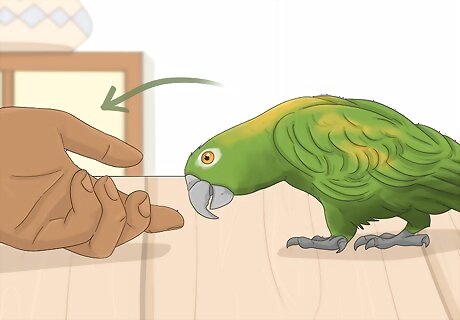
Let the bird come to you. Aggressive parrots might interpret any movement toward them as an attempt to hurt them. Instead of putting your hand right up to your aggressive parrot, place your hand (or a long wooden dowel) just outside the entrance to its cage. Letting your bird come to you gives it a sense of control, which can reduce its stress levels and (hopefully) instances of aggression. Don’t put your hand in the cage of an aggressive parrot. Doing so increases the odds of an aggressive incident. However, reward the bird for being bold by giving it a treat using a long wooden spoon. This reinforces the behavior you want while also keeping you safe. Always move slowly and in a relaxed way when handling your aggressive parrot. Otherwise, you might startle it, which could lead to aggression.
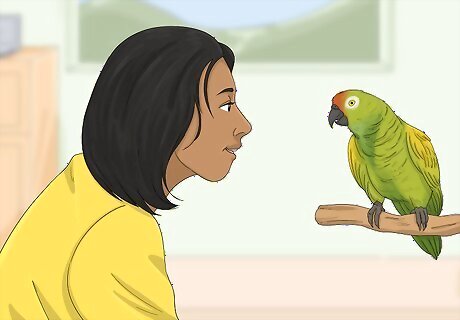
Socialize your parrot. If you live with others, their presence might cause your parrot to act aggressive. Place your parrot in a central location where it has an opportunity to interact with everyone. This will prevent your Amazon parrot from becoming over-bonded to just one person in the household, which can lead to aggression towards others. However, do not place your parrot’s cage in the center of a room or next to a door or window. Instead, place its cage in the corner of a room.
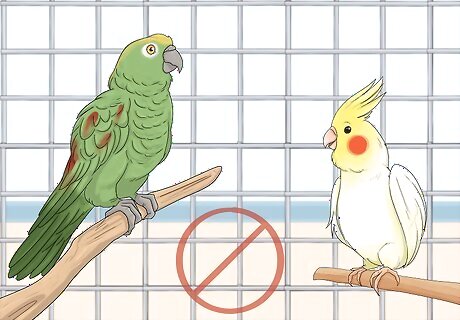
Segregate the Amazon parrot from other birds. If your Amazon parrot is housed with another bird, it might experience stress. Take your aggressive Amazon parrot’s cage-mate out and place it in a separate cage. This will both protect your other bird from the Amazon’s aggression and reduce your Amazon’s aggressive behavior .
Strengthening the Bond With Your Bird
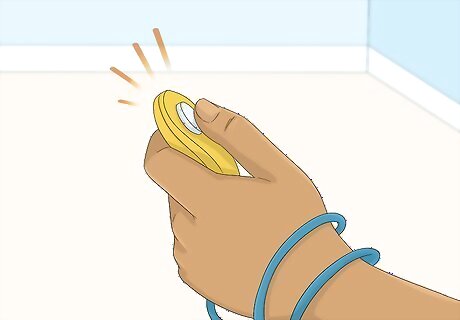
Use clicker training to teach your bird to be calm. Clicker training can be used for any behavior, including teaching your bird to stop being aggressive. To do this, you will reward the bird for calm behavior. First, teach it to associate the clicker with a treat. Push the clicker, then offer a treat on a long wooden spoon. After the bird comes to expect a treat after hearing the click, start to "click" good behaviors, providing a treat on the spoon. Your bird will start to repeat the desired calm behaviors to get treats. You can get a clicker from most pet stores or online. These are also marketed for use in dogs and cats. Have your treats ready before using the clicker while you are training the bird to associate the two. Always use a long wooden spoon or something similar to deliver the treat to your bird. This is to protect you from bites. Over time, you can close the distance between yourself and the bird as it shows calm behavior. Eventually, you may be able to handle the bird without aggression.
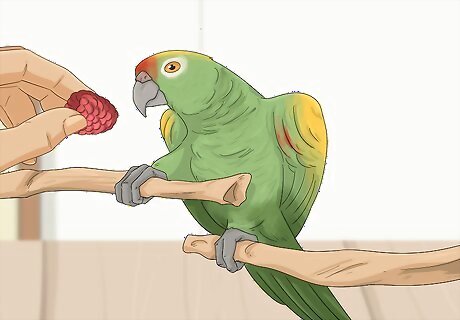
Train your bird to do tricks. When your bird is outside of its cage, teach it to do tricks. When your Amazon parrot is challenged mentally and physically, it might respond with a positive mood adjustment. For instance, you could teach your bird to alight on a particular perch. Right before feeding time, hold a small piece of food or a treat just in front of the perch you want it to land on. Give your aggressive Amazon parrot the snack when it lands on the perch. Repeat several times daily until your bird alights on the perch of your choice when you hold your hand in front of it.
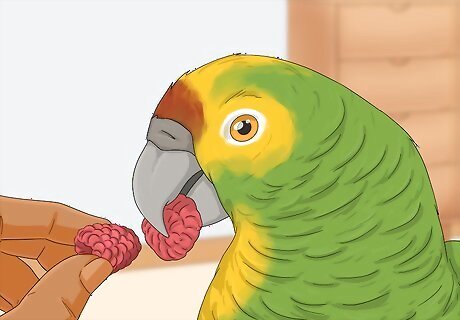
Reward your pet for good behavior. When your Amazon parrot is sitting quietly or playing, give it a favorite treat. You can either drop the favorite treat in your bird’s food dish or you can offer it by hand.

Let your Amazon out by hand. Never just open your Amazon’s cage and let it leave of its own volition. Instead, place your hand in its cage and wait for it to hop on, then slowly and carefully remove it. Wear a falconing glove or other protective handwear if you’re worried that your aggressive Amazon will bite your hand.

Spend time talking to your bird. One of the best ways to build a positive relationship between yourself and your Amazon parrot is by talking to it. You could say, “You are such a cute parrot” or “I love you” to your bird. You could also read to your bird. Even talking kindly to your bird as you make dinner can help it feel closer to you, thereby reducing its likelihood of aggression. Always use a warm and kind voice when speaking to your bird. Speak slowly and clearly, as if your bird is a small child.

Play with your parrot daily. Parrots love to play and spend time outside their cage. You could roll a soft ball toward your bird and let it catch it. You could play peek-a-boo with your bird by hiding under a blanket, then revealing yourself. Try a variety of games with your aggressive parrot to see if its demeanor changes. There is no minimum or maximum amount of time you need to spend playing with your parrot each day. Every parrot is different, and will require different levels of play and interaction.

Move the parrot at night and during the day. Move your bird’s cage to an isolated place at night. In the morning, move it back to its normal and preferred central location in the home. If the Amazon parrot becomes aggressive during the move from the isolated night-time location, leave it in the night location. Moving the cage in this way, your bird becomes dependent on you. This can lead the parrot to treat you more kindly and less aggressively. If the Amazon is aggressive toward someone else, they should be the one to move the cage.
Protecting Yourself
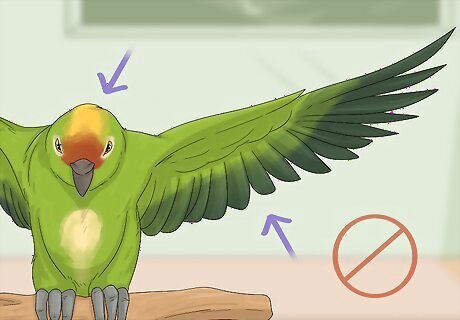
Don’t pet sensitive areas. Sometimes, even affection can cause your Amazon parrot to lash out. Certain areas -- including your bird’s back, under its wings, and around its tail -- should be left alone when interacting with your parrot.
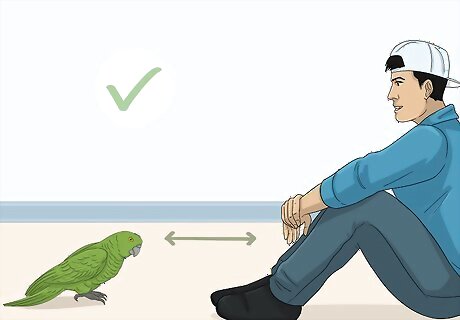
Maintain some physical distance from your aggressive Amazon parrot. Don’t allow your aggressive Amazon parrot to sit on your shoulder or bring your head close to it. Your aggressive pet might use this as an opportunity to work out some aggression and attack you.

Protect your limbs. An Amazon parrot’s bite can be quite hard. To avoid being bitten, wear falconer’s gloves or drape a thick towel over your hand and arm before handling your aggressive Amazon parrot. Additionally, you might want to have your Amazon hop a wooden dowel rather than on your hand.
Anticipating Aggression Related to Breeding Cycles

Mark your bird’s aggression on a calendar. After an aggressive episode, make a note on the corresponding calendar date describing what happened. For instance, you might write, “Bit my finger as I pet its back.” If the aggressive episode is related to hormonal changes, your Amazon parrot will likely repeat its aggressive act at about the same time next year.
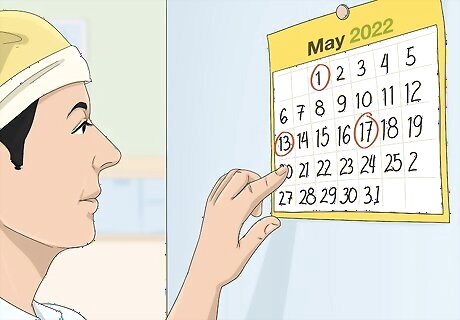
Review past calendar entries. Hold onto the calendar even after the year is through and, once weekly, review entries that occurred 50 or 51 weeks ago. As you approach the one-year anniversary of a particular act of aggression, adopt special handling procedures. For instance, in the week or two prior to the one-year anniversary of a particular act of aggression, use a hand-held perch and wear eyeglasses.
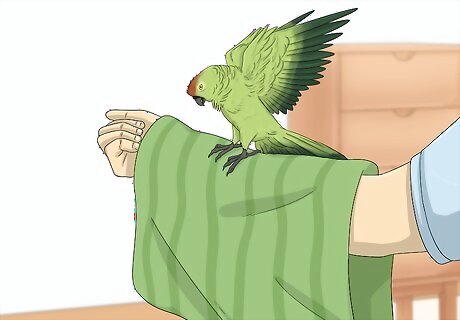
Use caution around Amazons during their breeding cycle. Aggressive behavior tends to increase during Amazons’ breeding cycle. During these periods, reduce direct contact with your bird by using a dowel and protecting your limbs with gloves or a towel. Move slowly and cautiously to avoid startling your aggressive Amazon parrot. You’ll know your parrot has begun its breeding cycle when it starts biting, screaming, flapping its tail or wings, and/or engaging in territorial behavior.

Limit your Amazon’s intake of starches and sugars during its breeding cycle. Foods with these ingredients can cause hormonal imbalances which make your parrot more aggressive. Therefore, avoid feeding your Amazon corn, potatoes, peas, or anything made from flour during the breeding cycle.
















Comments
0 comment